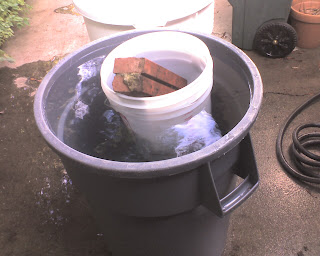I have a recipe for Grapefruit wine that we used last year to make about 10 gallons of it. It turned out really good, and so this year, we’re going to make 30 gallons.
However, the recipe I have is for just 1 gallon. I have a feeling that multiplying this recipe by 30 might cause any acceptable margin of error from the 1 gallon recipe to be way out of wack.
So, my plan is to set targets for the acid level and alcohol and then do lots of math and testing to figure out the best way to get there.
My goal is to make a medium dry or medium sweet wine with a PH between 3.1 and 3.4 and about 12% alcohol.
The recipe calls for the following ingredients (per gallon):
6 grapefruit
6 pints water
2.25 lbs sugar
1/4 tsp. Tannin
1 campden tablet
1 package champagne yeast
So, if we just multiple the recipe by 30, we’ll need:
180 grapefruit
180 pints water (22.5 gallons)
67.5 lbs sugar
7.5 tsp Tannin
30 campden tablets
maybe 6 packages of yeast?
So, we need to figure out if this is right, or what needs adjustment.
Right now, here are the numbers for the grapefruit:
pH: 2.4-2.5 (?!)
Sugar: 11.5 Brix
So, the first thing to do is to add enough water to the juice to make the acidity be acceptable.
The second thing is to add enough sugar to the mixture of juice and water to make the resulting wine have enough alcohol.
I need to find some charts and calculators. Here’s what I’ve found out so far:
– 11.5 Brix wine will make about a 5.8% alcohol wine (according to this: http://www.grapestompers.com/chaptalize_wine.asp)
– the above recipe adds 22.5 gallons of water (0 brix, 0 lbs sugar) to 7.5 gallons of juice at 11.5 brix (1 lb of sugar)…resulting in 7.5 lbs of sugar in 30 gallons of juice, or .25 lbs in 1 gallon…to make a 12.2% alcohol wine, you need to start with 22 Brix, or 2 lbs of sugar per gallon. So, we need to add 1.75 lbs per gallon…which is actually less than the recipe above calls for. Did I do the math right? If so, the orginal recipe would result in a 13.5% or so wine…which would actually be just fine. So, maybe we stick with the original sugar addition.




